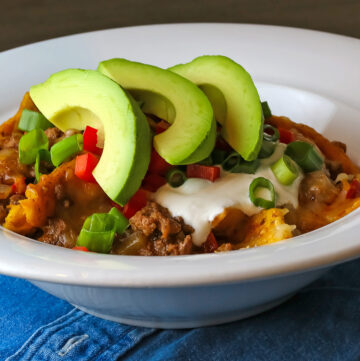The first time I had Romesco sauce was at Emeril’s New Orleans Fish House in Las Vegas. I was in town for COMDEX, a high tech convention along with about 200,000 of my closest friends. It was the mid-90s and Emeril was hitting his stride. His show “Essence of Emeril” on the Food Network was a huge hit and everyone in the country seemed to be echoing his legendary “BAM.” My dining companions that night didn’t have the same level of excitement as I did, but I knew we were in for a real treat.
Located in the MGM Grand, Emeril’s wasn’t a flashy restaurant by Las Vegas standards, but a lovely, comfortable and yet elegant space. Just the kind of place we were looking for after spending several very long days walking the concrete floor of the convention center. As we settled in with our drinks and perused the menu I grew even more exhilarated. I love New Orleans-style food and Emeril certainly knows how to showcase it.
Each course was delightful and my friends were all suitably impressed, but for me the highlight was my appetizer. It was a plate of succulent shrimp served on a bed of greens, with a piquant sauce called Romesco on the side. I had never had it before and didn’t know what to expect. My eyes widened with sheer delight as I took my first bite. My mouth filled with the bold flavors of the ground almonds, tomatoes, chiles and garlic.
Romesco originated in Tarragon, Spain and is common in Catalan cuisine. It was first prepared by fisherman in Catalonia and is still most often served with seafood. But it is also a wonderful addition to a variety of meats. Typically made with roasted almonds, hazelnuts, or a combination of the two, it has a rich earthiness that is delightful. Made by grinding the ingredients together in a food processor or blender, you can make it as chunky or smooth as you want and due to the addition of tomatoes and chiles it is usually light orange in color. Romesco sauce adds tremendous flavor to anything it is served with and because of its boldness, should be paired with other strong flavors as it can easily overpower more delicate foods.
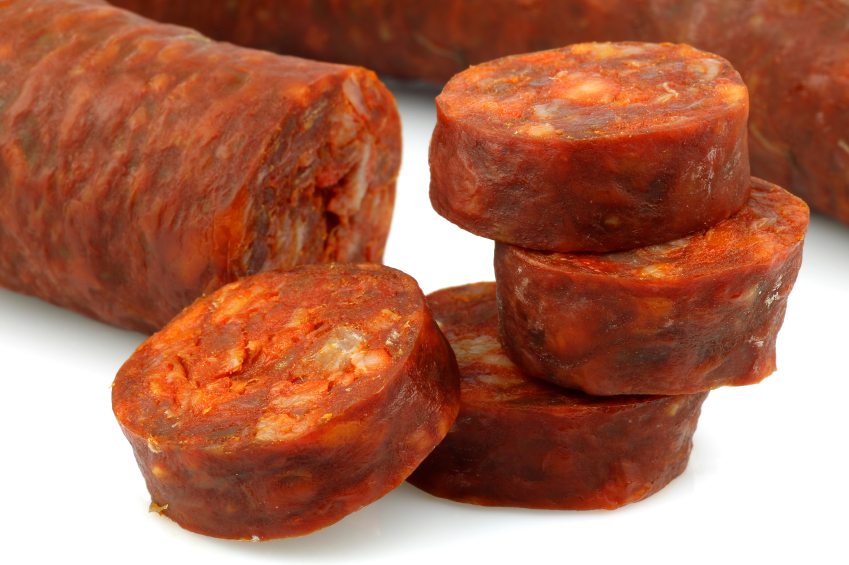
Sliced Chorizo sausages
One of the other key ingredients is the outstanding olive oil made in Spain. When we think of olive oil most people automatically consider Italy the primary producer. But Spain is the world’s biggest producer and consumer with hundreds of varieties to choose from. It is truly a matter of personal taste, but a few recommendations are Marques de Grinon, Marques de Valdueza, Nunez de Prado and Estornell. Always look at the bottling dates when buying oils to make sure you are getting a fresh bottle.
Romesco is fabulous in a number of applications. Don’t limit it to just saucing a plate. You can slather it on simple sandwiches, use it as a dip for vegetable crudite, it can be the base for soups, or simply spread it on grilled slices of bread for a delightful snack. Romesco is very easy to make, doesn’t take overly exotic ingredients, and stores up to a week in the refrigerator. If you put this on your buffet, it will be the most popular item at the party!
Today’s two recipes are from the cookbook “Sunday Suppers at Lucques” by Chef Suzanne Goin. Chef Goin built her skills by working under some of the country’s best chefs and restaurateurs including Alice Waters, Alain Passard, Todd English and Nancy Silverton. Alice Waters said, “She (Goin) was a standout. We all knew immediately she would have a restaurant of her own, and that other cooks would be coming to her for kitchen wisdom and a warm welcome.” This is very high praise considering that many great chefs are “graduates” of Chez Panisse.
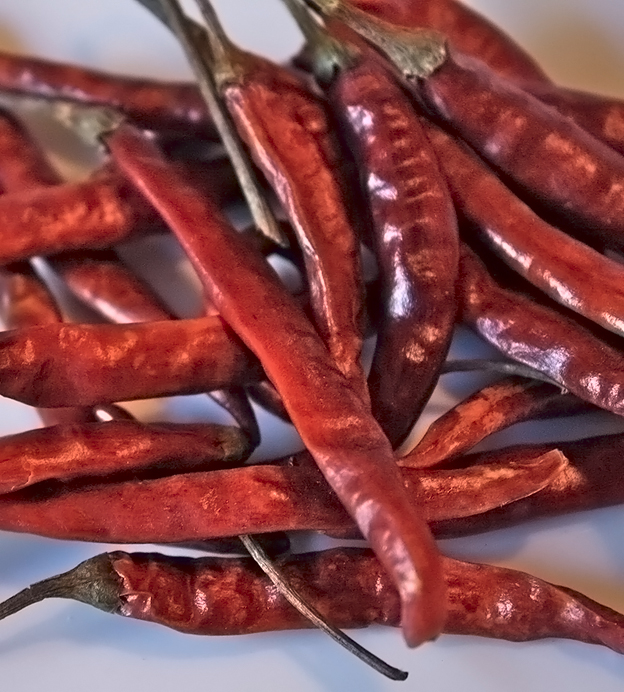
Arbol Chiles
The owner of four restaurants in Southern California (Lucques, AOC, The Hungry Cat, and Tavern) and the mother of three, Chef Goin has a hectic but satisfying life. She loves to watch the people she has mentored go out and find their own success. We can all wish we were lucky enough to have such a talented mentor in our life. Goin recommends focusing on learning as much as you can and following your passion. She says, “If you want to become a chef and you don’t love it more than anything on this earth, then get out now.”
Follow your own passion straight to the kitchen to make these wonderful recipes today!
Jane’s Tips and Hints:
Oils tend to turn rancid fairly easily, so store them in a cool place or in the refrigerator if you are not using them up quickly. This is especially important with oils from nuts such as walnuts, almonds, macadamias, and hazelnuts. Never use specialty oils for cooking – it is a waste of your money. Save them for salads and other preparations where they are showcased.
Gluten-Free Tips:
Romesco depends on bread for texture and thickening. Just use 2 slices of gluten-free bread to approximate the results. Look for gluten-free chorizo sausages. There are good-quality gluten-free hamburger buns available at most gourmet grocery stores and some specialty bakeries these days. And of course you can bake your own from scratch.
Kitchen Skill: How to Clean Hazelnuts (Filberts)
Hazelnuts (or Filberts if you are from Oregon) have a thin, papery covering that gets bitter when they are toasted. The easiest way to remove it is to place the hot nuts in a clean kitchen towel and rub them briskly back and forth between your palms. Work with small batches of nuts at a time and shake out the towel occasionally to remove the excess skins. The more you rub, the more of the skins will be removed. Using a coarse towel also helps.
If this is too much work (and at times it most definitely is, LOL) you can find husked hazelnuts at some gourmet stores including Trader Joes. I like to use those in baking for their unique sweet flavor.
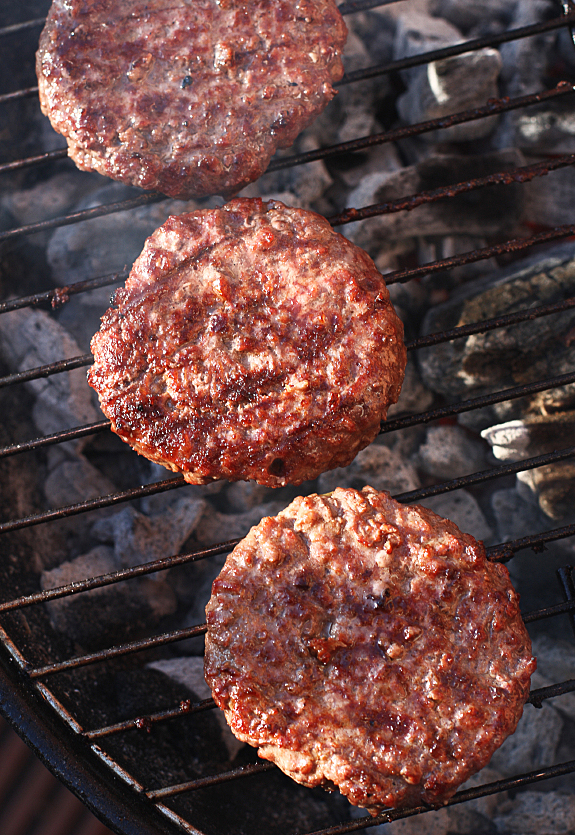

- Romesco Sauce
- 5 ancho chiles
- 2 tbsp raw almonds
- 2 tbsp blanched hazelnuts
- 1-1/4 cups extra-virgin olive oil
- 1 slice country bread, about 1-inch thick (substitute 2 slices gluten-free bread)
- 1/3 cup San Marzano canned tomatoes
- 1 clove garlic, chopped
- 1 tbsp chopped flat-leaf parsley
- 1/2 lemon, for juicing
- Kosher salt
- Burgers
- 1-1/2 tsp cumin seeds
- 3 tbsp extra-virgin olive oil, plus more for grilling
- 1/2 cup diced shallots
- 1 tbsp minced garlic
- 1 tbsp thyme leaves
- 2 chiles de arbol, thinly sliced on the bias
- 2 lb ground pork
- 1/4 lb fresh Mexican chorizo, casing removed (or use finely chopped Spanish chorizo) (or substitute gluten-free chorizo or sausage)
- 3 oz applewood-smoked bacon, finely diced
- 2 tbsp chopped flat-leaf parsley
- Toppings
- 6 slices Manchego cheese
- 6 brioche or other good quality burger buns (or buy/bake gluten-free buns)
- Mayonnaise, store-bought or your own homemade
- 2 oz arugula
- Kosher salt and freshly ground black pepper
- To make Romesco: Preheat oven to 375°F.
- Remove and discard stems and seeds from chiles, and then soak them in warm water for 15 minutes to soften. Strain chiles, and pat dry with paper towels.
- Meanwhile, spread nuts on a baking sheet and toast for 8 to 10 minutes, until they smell nutty and are golden brown.
- Heat a large saute pan over high heat for 2 minutes. Add 2 tbsp olive oil and wait a minute. Fry slice of bread on both sides until golden brown. Remove bread from pan and cool. Cut it into 1-inch cubes and set aside.
- Return pan to stove over high heat. Add 2 tbsp olive oil and chiles and saute for a minute or two. Add tomatoes. Season with 1/2 tsp salt and cook 2 to 3 minutes, stirring often, until tomato juices have evaporated and the tomato starts to color slightly. Turn off heat, and leave mixture in the pan.
- In a food processor, pulse together the toasted nuts, garlic, and fried bread until bread and nuts are coarsely ground. Add chile-tomato mixture, and process for 1 minute more.
- With the machine running, slowly pour in remaining 1 cup olive oil and process until you have a smooth puree. Don’t worry, the Romesco will “break” or separate into solids and oil; this is normal. Add parsley, and season to taste with lemon juice and more salt if you like.
- The sauce will keep for 2 weeks in the refrigerator. Try it on sandwiches, with cheese, eggs, grilled fish and roasted meats, as well as the recipe that follows, Romesco Potatoes.
- To make the burgers: In a medium saute pan, toast cumin seeds over medium heat a few minutes, until seeds release their aroma and darken slightly. Pound seeds in a mortar or spice grinder until coarsely ground.
- Return pan to the stove over high heat for 1 minute. Add olive oil and shallots. Turn heat down to medium-low, and cook for a few minutes, stirring once or twice, until shallots start to soften. Add garlic, thyme, cumin, and sliced chile. Season with 1/4 tsp salt and a few grindings of black pepper, and cook 3 to 4 minutes, until shallots become translucent. Set aside to cool.
- In a large bowl, use your hands to combine ground pork, chorizo, bacon, shallot mixture, and parsley, being careful not to overmix the meat. Season with 1-1/4 tsp salt and lots of freshly ground black pepper. Shape meat into six 6-oz patties. Chill in the refrigerator if not using right away. The flavors are even better when given time to meld, so if possible, mix the ingredients together the night before or the morning you will be preparing these burgers.
- Light the grill 30 to 40 minutes before cooking, and remove pork burgers from the refrigerator to come to room temperature (if you made them in advance). Clean the grill and rub the grate with an oiled paper towel to help with sticking.
- When coals are broken down, red, and glowing, brush pork burgers with olive oil, and grill them 3 to 4 minutes on the first side, until they’re nicely browned. Turn burgers over, and place a piece of cheese on each one. Cook another 3 minutes or so, until pork is just cooked through. (It should still be slightly pink in the center.)
- Slice buns in half, brush them with olive oil, and toast them on the grill, cut side down, for a minute or two, until they’re lightly browned.
- Spread both sides of the buns with mayonnaise. Place a burger on the bottom half of each bun, and dollop with a generous amount of Romesco. Place some arugula leaves on top, and finish with the top half of the bun.
- Serve the burgers with extra Romesco and mayonnaise on the side, if you like.
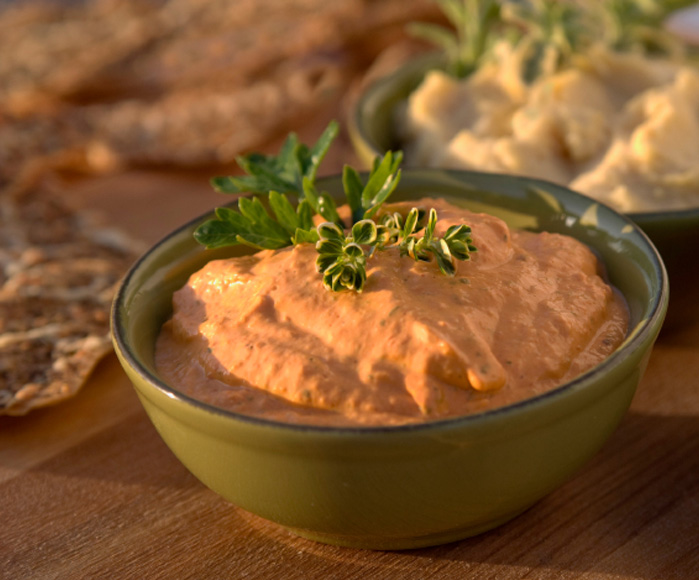

- 5 ancho chiles, stemmed and seeded
- 2 tbsp hazelnuts, blanched and skinned
- 2 tbsp raw almonds
- 1-1/2 pounds Yukon Gold potatoes
- 5 whole unpeeled cloves garlic
- 2 bay leaves
- 6 sprigs thyme, plus 2 tsp fresh thyme leaves
- Kosher salt and freshly ground black pepper
- 1-1/2 cups extra-virgin olive oil, divided
- 1 (1-inch thick) slice country bread
- 1/3 cup canned tomatoes
- 1 clove garlic, peeled and chopped
- 3 tbsp chopped flat-leaf parsley
- 1 to 2 tbsp lemon juice, or as needed
- Preheat oven to 375°F. Soak the chilies in warm water to soften, about 15 minutes, then drain and pat dry.
- Meanwhile, spread the hazelnuts and almonds on a baking sheet, and bake until fragrant and browned, 8-10 minutes. Remove from oven and raise heat to 400°F.
- Place potatoes in a roasting pan and add the 5 whole cloves garlic, bay leaves, thyme sprigs, and 1 heaping teaspoon salt. Drizzle with 2 tbsp olive oil. Cover tightly with foil and roast until potatoes are tender when pierced, about 50 minutes.
- Meanwhile, place a large sauté pan over high heat for 2 minutes. Add 2 tbsp olive oil and heat 1 minute. Add bread and fry until browned on both sides. Cut into 1-inch cubes, and reserve.
- Return pan to high heat, and add 2 tbsp olive oil and chiles. Sauté 1 minute and add tomatoes and 1/2 tsp salt, stirring until juices have evaporated. Remove from heat.
- In a food processor, combine the nuts, chopped garlic, and bread cubes. Pulse until coarsely chopped. Add chile-tomato mixture and pulse to combine. With machine running, slowly pour in 1 cup olive oil to make a smooth puree; the mixture may separate into solids and oil. Add 1 tbsp of the parsley and season to taste with lemon juice. Transfer to a bowl and set aside.
- When the potatoes are tender, remove from heat and let potatoes and garlic cool. Squeeze the garlic from its skins and set aside. Crumble the potatoes into chunky pieces with your hands.
- Place a large sauté pan over high heat for 2 minutes. Add the remaining 2 tbsp olive oil and heat for 1 minute. Working in batches if necessary (do not overcrowd the pan), add the potatoes and season with thyme leaves, salt, and pepper. Fry the potatoes until crispy on one side, 6 to 8 minutes, and then turn to brown on all sides. (If the potatoes stick to the pan, do not move them; they will eventually release.) When all the potatoes are browned, return them to the pan and add the Romesco sauce and garlic cloves.
- To serve, reheat if necessary, and toss with remaining 2 tbsp parsley.
Create a New Tradition Today!
Unauthorized use, distribution, and/or duplication of proprietary material on The Heritage Cook without prior approval is prohibited. This includes copying and reprinting content and photographs. If you have any questions or would like permission, I can be contacted via email: theheritagecook (at) comcast (dot) net. Feel free to quote me, just give credit where credit is due, link to the recipe, and please send people to my website, www.theheritagecook.com. Please see the Disclaimers page (under the “About” tab above) for additional details.
Thank You!







